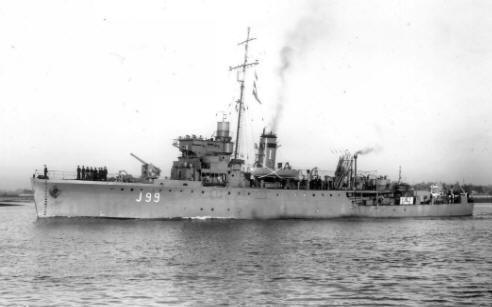
HMS Jason
Summary of History
HMS JASON (J99) was one of four
survey ships built to the same hull design as the Halcyon Class
minesweepers. Two, Franklin and Scott, were primarily designed for
surveying and had larger bridges than the minesweepers, a chartroom on
the upper deck aft, a full outfit of boats and a foremast stepped on
the forecastle in place of ‘A’ gun from which the beaconing derrick
was rigged. No provision was made in their fitting out for their
conversion to minesweepers. The other two
(JASON and
Gleaner)
were designed primarily for minesweeping and simply fitted for
their survey role. No armament was to be fitted, though the Survey
Minesweeping Sloops were fitted for but not with the standard
Halcyon armament of 2 x 4-inch guns and small arms. All
wiring and strengthening
was built into these two to allow for their speedy conversion to full
minesweeping configuration on the outbreak of war.
JASON
was laid down at Ailsa (Troon) on 12th Dec 1936 and was commissioned on
21st April 1938 (some accounts say 9th June). She carried out surveys on
the south coast of England and the Bristol Channel. On 23rd August 1939
she was ordered to proceed to her home port for conversion to a
minesweeper. On 14th September it was decided she should in fact convert
to an Anti/Submarine vessel instead, fitting extra depth charge
arrangements. She then commenced her escort duties, based in Rosyth.
These lasted until 24th August 1942 when she went to Leith and was
converted to become a
minesweeper, she was also 'arcticised'. She completed working up on
27th January 1943 and on 15th Feb sailed for Murmansk as part of the
ocean escort to JW53. The convoy met severe weather (the cruiser
Sheffield had the
armour plate torn off her A-turret by the heavy sea) and Commander Lewis
JASON, who was in charge of the escort, earned Tovey’s praise for his
achievement in keeping even a semblance of order in the confusion. JASON
remained in North Russia until 1st November 1943 when she returned with
RA54A. JASON's crew had endured the daily air attacks and carried
out the many duties expected of them to a very high standard. Rear
Admiral Archer (SBNO North Russia) wrote:
With this convoy went HMS JASON (Commander H G A Lewis RN) and HMS
Britomart (Lt Commander S S Stamwitz DSC) who had also made a
lengthy stay in North Russia. I cannot speak too highly of the
service they have given during this period or the manner in which
both Commanding Officers have maintained the morale of their ships’
companies. They leave a very good name behind them with the Russians
who even offered to buy the ships, so impressed were they.
HMS JASON then had a refit at Portsmouth
and when she completed in Feb 1944 commenced exercises in preparation for
D day with the 1st Minesweeping Flotilla. On D Day she and the rest of the
Flotilla successfully swept Channel 9 into Sword Beach for Canadian
troops. She then continued to clear mines and provide protection for the
invasion fleet over the next few weeks. On 27th August 1944 the flotilla
came under attack from two squadrons of rocket firing Typhoons which, due
to an error, had been ordered to destroy the ships. (See
Friendly Fire for the full
account). Although damaged and losing two crew members, she was fortunate
not to suffer as severely as her sister ships Britomart and Hussar (both
sunk) and Salamander (constructive loss).
HMS Jason then went to Harwich for refit
and spent the rest of the war based there clearing mines between the East
Coast and the Continent. She never returned to her minesweeping role. In
August 1946 she was reduced to the Reserve and in September was
sold to Wheelock Marden
& Co for conversion to cargo vessel; renamed Jaslock. In
1950 she was scrapped at Grays, Essex.
Commissioned and on Home Service
until 11.38. Served in 1st A/S Striking Force 10.39; 3rd A/S S F
Western Approaches 1.40; 3rd A/S S F Rosyth 4.40; Rosyth Escort
Force 9.40, 6th MSF 12.42; 1st MSF 1.43; Fishery Protection 5.46 -
8.46.
See also
www.naval-history.net

